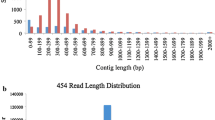Abstract
Single Nucleotide Polymorphisms (SNPs) are the commonest type of nucleotide variation distributed throughout the genome and have enormous potential to saturate genetic maps. However, their identification is constrained by the huge investment required for their detection. In this study, we used publicly available EST (Expressed Sequence Tag) sequences to identify SNPs in Sorghum bicolor. A total of 12,421 putative SNPs were identified from 2,921 contiguous transcripts leading to an average SNP interval of one putative SNP for every 275.26 bp. The proportion of transition type mutations (0.598) was larger than transversion types conforming to biological expectations. In order to demonstrate the utility of the SNPs for development of markers with relatively cheap assays, we experimentally validated SNPs using Single Strand Conformation Polymorphism (SSCP) technique in sorghum accessions, which are used as parents for development mapping populations. Genotyping these parents of mapping populations with SSCP markers showed up to 33% polymorphism in the markers suggesting that the SNPs can be used as potential resource for S. bicolor crop improvement programs.
Similar content being viewed by others
References
Batley J, Baker G, O’Sullivan Edwards KJ, Edwards D. 2003. Mining for single nucleotide polymorphisms and insertions/deletions in maize expressed sequence tag data. Plant Physiol. 132:84–91
Buetow KH, Edmonson MN, Cassidy AB. 1999. Reliable identification of large numbers of candidate SNPs from public EST data. Nat. Genet. 21: 323–325
Ching A, Katherine SC, Mark J, Maurine D, Oscar S, Scott T, Michele M, Anthony JR. 2002. SNP frequency, haplotype structure and linkage disequilibrium in elite maize inbred lines. BMC Genet. 3: 19–32
Coles ND, Coleman CE, Christensen SA, Jellen EN, Stevens MR, Bonifacio A, Rojas-Beltran JA, Fairbanks DJ, Maughan PJ. 2005. Development and use of an expressed sequenced tag library in quinoa (Chenopodium quinoa Willd.) for the discovery of single nucleotide polymorphisms. Plant Sci. 168: 439–447
Duran C, Appleby N, Vardy M, Imelfort M, Edwards D, Batley J. 2009. Single nucleotide polymorphism discovery in barley using autoSNPdb. Plant Biotechnol. J. 7: 326–333
Edwards NJ. 2007. Novel peptide identification from tandem mass spectra using ESTs and sequence database compression. Mol. Syst. Biol. 3: 102
Eujayl I, Sorrells M, Baum M, Wolters P, Powell W. 2001. Assessment of genotypic variation among cultivated durum wheat based on EST-SSRS and genomic SSRs. Euphytica. 119: 39–43
Gu Z, Hillier L, Kwok PY. 1998. Single nucleotide polymorphism hunting in cyberspace. Hum. Mutat. 12: 221–225
Hawken RJ, Wesley CB, Sean M, Brian PD. 2004. An interactive bovine in silico SNP database (IBISS). Mammalian genome. 15: 819–827
Holliday R, Grigg, GW. 1993. DNA methylation and mutation. Mutat. Res. 285: 61–67
Hu G, Modreck B, Stensland HM, Saarela J, Pajukanta P, Kustanovich V, Peltonen L, Nelson SF, Lee C. 2002. Efficient discovery of single-nucleotide polymorphisms in coding regions of human genes. Pharmacogenomics J. 2: 236–242
Irizarry K, Kustanovich V, Li C, Brown N, Nelson S, Wong W, Lee CJ. 2000. Genome-wide analysis of singlenucleotide polymorphisms in human expressed sequences. Nat. Genet. 26:233–236
Kota R, Rudd S, Facius A, Kolesov G, Thiel T, Zhang H, Stein N, Mayer K, Graner A. 2003. Snipping polymorphisms from large EST collections in barley (Hordeum vulgare L.). Mol. Genet. Genomics. 270: 24–33
Krishna TG, Jawali N. 1997. DNA isolation from single or half seeds suitable for random amplified polymorphic DNA analyses. Anal. Biochem. 250: 125–127
Lopez-Crapez E, Bazin H, Chevalier J, Trinquet E, Grenier J, Mathis G. 2005. A separation-free assay for the detection of mutations: combination of homogeneous time-resolved fluorescence and minisequencing. Hum. Mutat. 25: 468–475
Orita M, Suzuki Y, Sekiya T, Hayashi K. 1989. Rapid and sensitive detection of point mutations and DNA polymorphisms using the polymerase chain reaction. Genomics. 5: 874–879
Paterson AH. 2008. Genomics of Sorghum. Intl. J. Plant Genomics. Article ID 362451
Paterson AH, Bowers JE, Bruggmann R, Dubchak I, Grimwood J, et al. 2009. The Sorghum bicolor genome and the diversification of grasses. Nature. 457: 551–556
Picoult-Newberg L, Ideker TE, Pohl MG, Taylor SL, Donaldson MA, Nickerson DA, Boyce-Jacino M. 1999. Mining SNPs from EST databases. Genome Res. 9: 167–174
Somers DJ, Kirkpatrick R, Moniwa M, Walsh A. 2003. Mining single-nucleotide polymorphisms from hexaploid wheat ESTs. Genome. 46: 431–437
Stone RT, Grosse WM, Casas E, Smith TP, Keele JW, Bennett GL. 2002. Use of bovine EST data and human genomic sequences to map 100 gene-specific bovine markers. Mammalian Genome. 13: 211–215
Thiel T, Kota R, Grosse I, Stein N, Graner A. 2004. SNP2CAPS: a SNP and INDEL analysis tool for CAPS marker development. Nucl. Acids Res. 32: e5
Tsang S, Sun Z, Luke B, Stewart C, Lum N, et al. 2005. A comprehensive SNP-based genetic analysis of inbred mouse strains. Mammalian Genome. 16: 476–480
Vogel C, Chothia C. 2006. Protein family expansions and biological complexity. PLoS Computational Biol. 2: e48
Author information
Authors and Affiliations
Corresponding author
Additional information
Source: A total of 185,593 EST sequences were retrieved from FTP site of Sorghum bicolor NCBI UniGene database (ftp://ftp.ncbi.nih.gov/repository/UniGene/Sorghum_bicolor/)
Rights and permissions
About this article
Cite this article
Girma, Y., Doddamani, D., Fakrudin, B. et al. Mining of gene-based SNPs from publicly available ESTs and their conversion to cost-effective genotyping assay in sorghum [Sorghum bicolor (L.) Moench]. J. Crop Sci. Biotechnol. 17, 155–160 (2014). https://doi.org/10.1007/s12892-014-0022-4
Received:
Revised:
Accepted:
Published:
Issue Date:
DOI: https://doi.org/10.1007/s12892-014-0022-4




